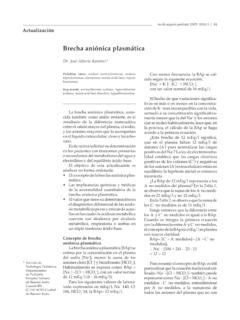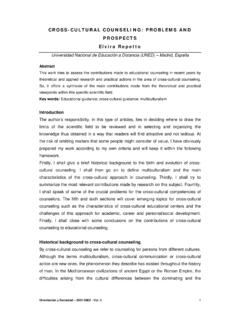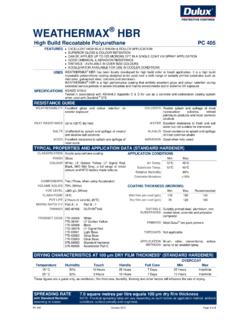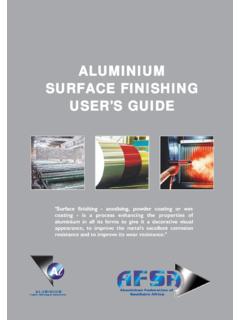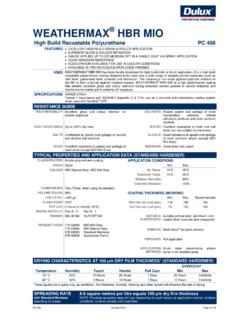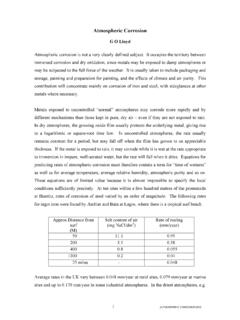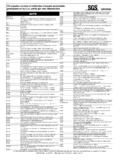Transcription of MANUFACTURE AND TESTING OF WATER-BORNE …
1 Latin American Applied Research 36:149-154 (2006) 149 MANUFACTURE AND TESTING OF WATER-BORNE PAINTS BY USING VINYL LATEX CONTAINING VeoVa10 MONOMER A. C. AZNAR and J. I. AMALVY , ,* CIDEPINT, Centro de Investigaci n y Desarrollo en Tecnologia de Pinturas (CIC-CONICET). Av 52 entre 121 y 122, (1900) La Plata, Argentina. INIFTA (Facultad de Ciencias Exactas, Universidad Nacional de La Plata), Diag. 113 y 64 CC 16 Suc. 4 (1900) La Plata, Argentina Abstract Two different WATER-BORNE dispersions (latex) containing different amounts of vinyl acetate and a commercial vinyl ester monomer (VeoVa10) were evaluated by incorporating them in paint for-mulations for wall protection. Three paint formula-tions were prepared with different PVC values. The main properties such as hiding power, washability, tension of adhesion, and elasticity were assessed.
2 Changes in color, gloss and adhesion and the exten-sion of chalking, checking, cracking and blistering were also evaluated in normal and accelerated weathering tests. The results indicate that both dis-persions are suitable for wall protection (interior or exterior, permanent or temporary protection) and they are compatible with the most common additives used in the Argentinean and Mercosur markets. The presence of VeoVa10 in the binder composition im-proves the water and UV resistances of the paint. A styrenic-acrylic latex, commonly used in the local market, was used as comparative product. Keywords WATER-BORNE paints, vinyl binders VeoVa10 latex, wall protection I. INTRODUCTION Latex dispersions for water-based coating formulations with low amount (or zero) of volatile organic com-pounds (VOCs) are obtained typically from emulsion polymerization. To produce decorative and long lasting films adequate pigments, fillers and additives are added.
3 With the purpose of obtaining the best coating per-formance with a good balance of price, it is necessary to add the smallest quantity of binder. Considering that the binder is both the promoter in the adhesion of the film coating to the substrate and the pigment packing and the fillers, a large quantity of binder reduces the hiding power of the coating . Latex paints are most commonly applied on in- and outdoor masonry substrates. In the first case, the decora-tive feature is intended to be highlighted (color, gloss, film uniformity), and in the second one the resistance to aggressive agents of the environment against the film coating (UV-radiation, humidity, rain, pollution, high temperature). Other properties such as hardness, elasticity and ad-hesion should be suitable enough to last ageing. Poly-meric vinyl dispersions have been used for the formula-tion of water-based coating to be applied on masonry (Flick, 1975).
4 However the slight resistance to water and to UV radiation of the films has limited their use and they have been substituted by acrylic dispersions that posse better resistance properties, but with a higher cost. The introduction of new vinyl compounds has con-tributed to the development of vinyl dispersions with better properties. In particular a Vinyl ester of Versatic acid known as VeoVa (Shell Chemicals, 1988), which contains a polimerizable double bond, has been success-fully used. The general chemical formula of the VeoVa is shown in Fig. 1, where R1 and R2 are (branched) alkyl groups. CCCCCOOHHHHHHR1R2double bondCCCCCOOHHHHHHR1R2double bond Figure 1: Chemical structure of VeoVa. According to the total number of carbon atoms three derivatives VeoVa9, VeoVa10 and VeoVa11 are known. In this work dispersions which contain 10 car-bon atoms isomers VeoVa10, for which R1+R2 = C7H16 were tested.
5 The (co)polymerization in emulsion of VeoVa10 with vinyl acetate (VAc) originates vinyl latex that pro-duces films with better water resistance, UV-resistance and alkali resistance which lead to superior durability higher than those produced by pure vinyl latexes (Aten and Vegter, 1970). VeoVa and VAc have similar reac-tivity in radical polymerization (Resolution Perform-ance Products, 2001) and the random (co)polymeriza-tion protects the ester group of VAc from hydrolysis through the so-called "umbrella effect", improving the hydrolytic stability of the polymer (Decocq et al., 1999). This enables such polymers to be successfully used as paint binders on alkaline substrates, such as ex-terior concrete. The highly branched hydrophobic struc-Latin American Applied Research 36:149-154 (2006) 150 ture of VeoVa also enhances the latex and final coating properties.
6 Additionally, VeoVa10 based polymers ex-hibit the required hardness/flexibility for the formula-tion of a range of high-performance interior and exterior latex paints (Decocq et al., 1999). Copolymerization with non-vinyl monomers is also possible. For example a solvent-free binder of low MFFT has been recently developed using 2-HEA as (co)monomer (Hendrick and Nootens, 2001). VAc/VeoVa10 based latex can be stabilized by sur-factants and a functional monomer as a colloid-free sys-tem, or by a combination of surfactants and protective colloid giving in this way a colloid-stabilized system. On the other hand, depending on the total number of carbon atoms, the polymer exhibits different glass tran-sition temperature (Tg) values. VeoVa content modifies also the final Tg of the polymer and therefore the water and UV resistances. These are essential facts to obtain a high performance coating . A good review about properties and applications of dispersion containing VAc and VeoVa copolymers has been recently published (Vandenzande e al.)
7 , 1997). In Europe, architectural paints represent over 90% of the market for VeoVa10 dispersion. Nearly, one-half of these latexes are used for interior applications and the other half is divided between exterior and general mar-kets (Vandenzande et. al 1997). Substrates in Europe are quite different from those typically used in the United State of America (USA) due to the construction meth-ods. In the USA the use of paper-faced drywall is com-mon but in Europe the majority of substrates are inor-ganic, including brick and concrete. Thus, additional alkaline resistance is expected in this case. The different substrate properties then modify the type and relative amounts of vinyl acetate containing resins. In both re-gions, Europe and USA, the vinyl-based resins domi-nate, but the binder composition is different between the two regions. Vratsanos (2001) has reported that the VAc resins in the European Union are mainly VAc/VeoVa resins, about 34% of the overall market.
8 Vinyl/acrylics dominate the US market with 61% of the overall water-based architectural market. Significantly, more styrene acrylic resin is used in the EU, while the amounts of acrylic are roughly comparable (Anonymous, 1998). In Argentina, the use of vinyl resins is also important and the substrates used are similar to those used in Europe, so VAc/VeoVa10 resins could be good performance binders. However, as far as the authors knowledge no studies or lab tests using (co)polymers of VeoVa monomers in a typical local paint formulation are avail-able, so the aim of this work was to test two types of WATER-BORNE dispersions containing 20% and 30% w/w of VeoVa10. As stated above the dispersions used were colloids stabilized, which show a rather different behav-ior compared to the common surfactant stabilized dis-persions (Bondy and Coleman, 1970). Having in mind only comparative purposes and taking into account the possible differences arising from the stabilizing sys-tems, a typical styrenic-acrylic dispersion of common use in the local market was included in this study.
9 II. METHODS A. Latex dispersions The latex dispersions used in this work were kindly supplied by Shell Chemicals (Netherlands). The solid content of VAc/VeoVa10 dispersions was 54 1%. MFFT and particle sizes were 17 1 C and 460 20 nm respectively for the 80/20 dispersion; and 15 1 C and 420 20 nm respectively for the 70/30 dispersion (data from the supplier). The solid content of styrenic/acrylic dispersion was 50 %, MFFT ca. 18 C and the particle size about 100 nm (data from the supplier). B. coating preparation A typical high-speed disperser (working range from 1,200 to 2,600 rpm) having a container of double bot-tom water-cooled so as to work at less than 30 C, was used in order to obtain the paint dispersions. The con-tainer was filled with the whole amount of water of the formulation where the thickener/antisettling agent had been previously added.
10 Agitation started with the selec-tive addition of the remaining additives and pigments. After that, speed increased up to the highest level until a 20/30 grade of dispersion, according to ASTM D 1210 (2001). Finally, the milling system speed decreased and the latex dispersion was added agitating it in order to obtain a full homogenization. C. Composition and formulation of coatings The amount and types of pigments together with the used fillers are considered in the composition of coat-ings. They contribute to the hiding power and to the pigment volume concentration (PVC) of the coating film. The following additives were selected for the preparation of the latex paints: - Dispersing agent naphthenate-formaldehide sodium salt obtained by condensation (25% in water). - Thickener and colloid protector hidroxypropyl-methylcellulose 4000 cp enough to obtain a final paint of 66 KU Stormer viscosity.

